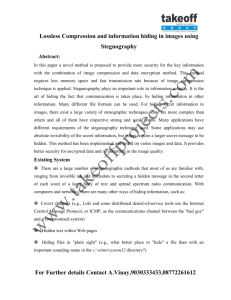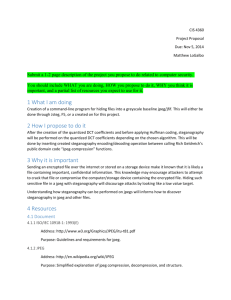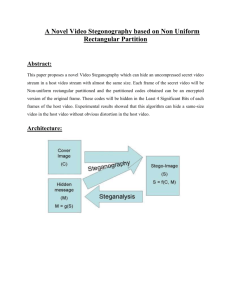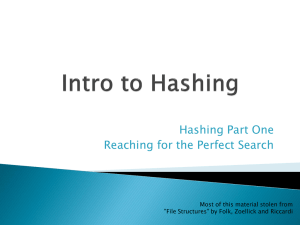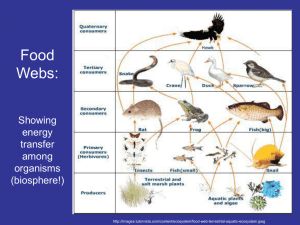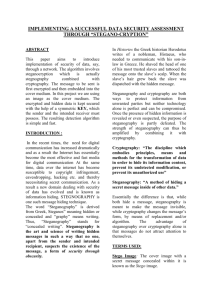Lecture 2 - Health Computing: Pitt CPATH Project
advertisement
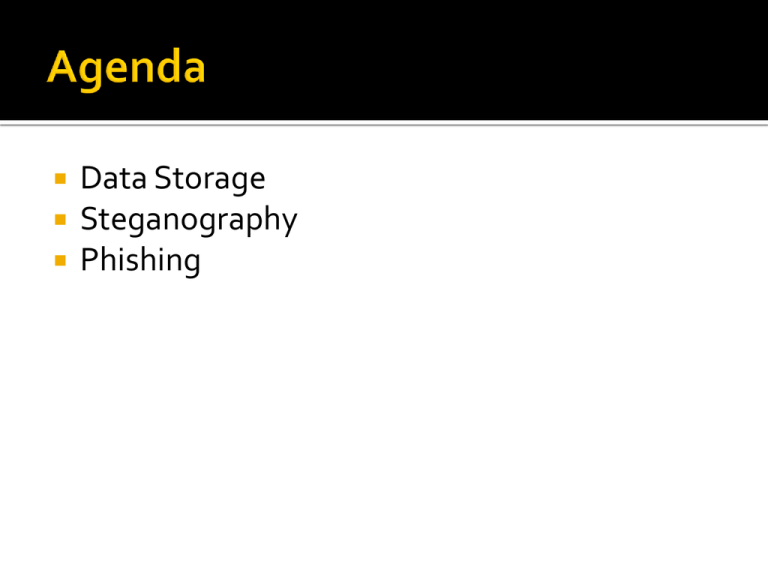
Data Storage Steganography Phishing How are files stored? Each file is assigned one or more sectors in the disk. If the file is small enough, not all the sector will be used. The unused space is called a Slack space We can save information there using a special editor. How do you know that the data you stored hasn’t been modified? Hash functions What is a hash function? Is a function with an special algorithm that finds a value given a file. Each file has a unique hash value. Even small changes in a file can generate totally different hash values. First get the hash values: Hash value original file Hash value modified file Now let’s open the modified file: Entire phrase: Try to make other changes (possibly random) to the file and save the file with another name, but retaining the extension. Can you execute the new file? Explain why or why not? Close all windows. Each byte represents a shade red, blue or green. Random changes to the least priority bit generally produce only slight changes of shade Resulting Shade Go to desktop/Exercises/3.0 Steganography/ Double-click on the “Jphswin.exe” Hide data into “jpeg” file. Click on Open Jpeg on the menu bar and open the file “KaalBhairava.jpg” in “data” sub-folder. Create a text file “input.txt” with some text in the “data” folder. Click on Hide on the menu bar and give a password of your choice as prompted. Then, as prompted, point to the file “input.txt” that you intend to hide. Lastly, use save jpge as to save the image as “hidden.jpg” in the “data” sub-folder. The message text in “input.txt” has been hidden in the jpeg image file “hidden.jpg”. Close all open files and the JPHS application. Retrieve the hidden message from the “jpeg” file. Open the file “hidden.jpg” using the Steganography tool “Jphswin.exe”. Click on Seek on the menu bar. Then, as prompted, save the file as hidden “output.txt” into the “data” folder. Hide messages in such a way that no one, apart from the sender and intended recipient, suspects the existence of the message, a form of Security through obscurity What other types of files can be used? Documents, images, audio files… Hide relatively small amount of data in other data files that are significantly larger What is it useful for? Send secret messages Watermarking products for proprietary issues PRESIDENT'S EMBARGO RULING SHOULD HAVE IMMEDIATE NOTICE. GRAVE SITUATION AFFECTING INTERNATIONAL LAW. STATEMENT FORESHADOWS RUIN OF MANY NEUTRALS. YELLOW JOURNALS UNIFYING NATIONAL EXCITEMENT IMMENSELY. Can you find the hidden message? PERSHING SAILS FROM NY JUNE I. Example of Steganography (Text – page 48) Dear George, Greetings to all at Oxford. Many thanks for your letter and for the summer examination package package. All entry forms and fees forms should be ready for final dispatch to the syndicate by Friday 20th or at the latest I am told by the 21st. Admin has improved here though there is room room for improvement still; just give us all two or three more years and we will really show you! Please don’t let these wretched 16+ proposals destroy destroy your basic O and A pattern. Certainly this sort of change, if implemented immediately, immediately would bring chaos. Sincerely yours, INFSCI 2935: Introduction to Computer Security 16 Please go to: http://wombatsecurity.com/antiphishing_phil/index.html “Phishing e-mail messages are designed to steal your identity. They ask for personal data, or direct you to Web sites or phone numbers to call where they ask you to provide personal data” [1]. Steps: Gain your trust Ask for personal information Logos that look real They may use information learnt in social networks They may seem to come from someone you trust In Firefox if you step over the address, you’ll see the real URL. Like here: If the web page is trusted by your browser, you’ll see something like this: Firefox: In Internet Explorer: Are these two fine? ▪ https://www.bankofamerica.com/index.jsp ▪ https://www.bank○famerica.com/index.jsp What are browsing cookies? HTTP is stateless ▪ Each HTTP request and response are treated in isolation ▪ Hard for web servers to determine their state with the client they are serving Cookies are used to maintain state information ▪ ▪ ▪ ▪ ▪ Authentication Session tracking Storing site preferences Shopping cart contents Identifier for a server-based session Now you can see what the owner was looking at: TYPE URL MODIFIED TIME ACCESS TIME FILENAME DIRECTORYHTTP HEADERS Cookies can be used as spyware Track internet users' web browsing habits Web pages visited Order Time A small graphic on a web page that allows sites to track user activities How they work? Typically 1 pixel X 1 Pixel images that cannot be seen The image is loaded by a page from Site X The image itself comes from Site Y Site X and Site Y now have exchanged information about the user’s web activities E.g. : “Alice has visited msnbc.com and has gone to the sports page” ---> SupplyAds.com ----> Ad for NBA gear Use tools like Bugnosis for IE to detect web bugs ERASING COOKIES PRIVATE BROWSING Thank you http://www.microsoft.com/protect/fraud/phi shing/symptoms.aspx Some of the examples were taken from: 1. http://antivirus.about.com/od/emailscams/s s/phishing.htm 2. http://www.utsa.edu/oit/images/MSC/phishi ng_example3.gif 1. http://www.sis.pitt.edu/~cybercard/lab/lab_p age.htm

